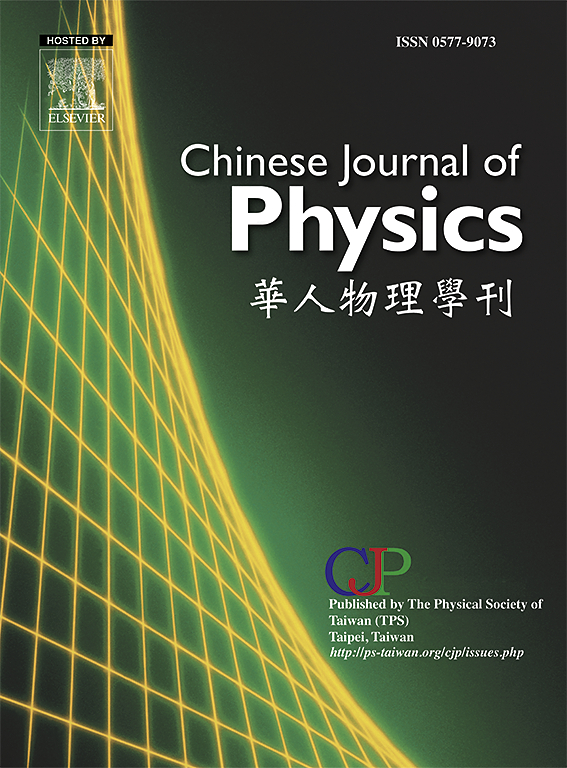三元混合纳米流体在弯曲渗透表面上流动的辐射效应和发热效应的对比研究:稳定性分析
IF 4.6
2区 物理与天体物理
Q1 PHYSICS, MULTIDISCIPLINARY
引用次数: 0
摘要
三元混合纳米流体在交通、电子和能源领域应用广泛。这些领域包括太阳能集热器、现代电子设备冷却系统、核反应堆、飞机和汽车。因此,本研究探讨了三元混合纳米流体流过具有质量吸力的弯曲伸缩表面的非稳态流动。将 Fe3O4、Al2O3 和 ZnO 纳米材料浸入煤油或水等基液中,形成三元混合纳米流体。此外,还考虑了随时间变化的磁场、热辐射和发热的影响。应用合适的相似变量将偏微分方程转换为常微分方程。然后,使用 MATLAB 中的 bvp4c 求解器对这些方程进行数值求解。在特定的拉伸/收缩参数范围内发现了二元解。为了建立稳定的解,通过计算最小特征值进行了稳定性测试。结果表明,三元混合纳米流体的双解范围更大。通过增加磁参数和发热参数,提高了热传输率。煤油的速度和剪切应力曲线较高,而水作为基础流体的温度曲线较高。流体速度和剪切应力与磁性参数和吸力参数有直接关系,而流体温度与它们有反向关系。通过增加辐射参数和发热参数可以提高流体温度。稳定性测试表明,只有第一种方案是稳定的,而第二种方案是不稳定的。这项研究的一些潜在用途包括高温和冷却过程、药物、生物传感器、航空航天技术和金属涂层。本文章由计算机程序翻译,如有差异,请以英文原文为准。

Comparative investigation on radiative and heat generation effects of ternary hybrid nanofluid flow over a curved permeable surface: Stability analysis
Ternary hybrid nanofluid has numerous applications in transportation, electronics, and energy sectors. These include solar collectors, modern electronic devices cooling systems, nuclear reactors, aircraft, and automobiles. Therefore, the unsteady flow of a ternary hybrid nanofluid past a curved stretching/shrinking surface with mass suction is explored. The nanomaterials of Fe3O4, Al2O3 and ZnO are immersed in a base fluid such as kerosene oil or water to form a ternary hybrid nanofluid. The impacts of time-dependent magnetic field, thermal radiation, and heat generation are also considered. Suitable similarity variables are applied for the conversion of partial differential equations into ordinary differential equations. Then, these equations are solved numerically with bvp4c solver in MATLAB. Dual solutions are discovered in a particular range of stretching/shrinking parameter. To establish a stable solution, a stability test is implemented by computing the smallest eigenvalues. The results yield that dual solutions range is higher with ternary hybrid nanofluid. The heat transport rate is elevated by growing the magnetic parameter and heat generation parameter. The profiles of velocity and shear stress are higher with kerosene oil while the temperature profile is higher with water as the base fluid. The fluid velocity and shear stress have a direct relation with magnetic parameter and suction parameter while the fluid temperature has an inverse relation with them. The fluid temperature is escalated by augmenting the radiation parameter and heat generation parameter. The stability test confirms that only the first solution is stable whereas the second solution is unstable. Some potential uses for this study include high-temperature and cooling processes, medications, biosensors, aerospace technologies, and metallic coatings.
求助全文
通过发布文献求助,成功后即可免费获取论文全文。
去求助
来源期刊

Chinese Journal of Physics
物理-物理:综合
CiteScore
8.50
自引率
10.00%
发文量
361
审稿时长
44 days
期刊介绍:
The Chinese Journal of Physics publishes important advances in various branches in physics, including statistical and biophysical physics, condensed matter physics, atomic/molecular physics, optics, particle physics and nuclear physics.
The editors welcome manuscripts on:
-General Physics: Statistical and Quantum Mechanics, etc.-
Gravitation and Astrophysics-
Elementary Particles and Fields-
Nuclear Physics-
Atomic, Molecular, and Optical Physics-
Quantum Information and Quantum Computation-
Fluid Dynamics, Nonlinear Dynamics, Chaos, and Complex Networks-
Plasma and Beam Physics-
Condensed Matter: Structure, etc.-
Condensed Matter: Electronic Properties, etc.-
Polymer, Soft Matter, Biological, and Interdisciplinary Physics.
CJP publishes regular research papers, feature articles and review papers.
 求助内容:
求助内容: 应助结果提醒方式:
应助结果提醒方式:


